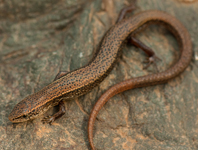Abstract
The genus Neurisothrips is known only from the Hawaiian Islands, where it has radiated into a considerable number of species. No other species of the worldwide family Thripidae is endemic to Hawaii, and the lack of structural diversity amongst the members of this genus might suggest that they are derived from a single ancestral introduction. The phylogenetic relationships of Neurisothrips are unclear, but it is possibly derived from Frankliniella, the most species-rich Thripidae genus on the American continent. A key is provided to 14 recognised species of which the following seven are newly described: N. bidens sp. n., N. fran sp. n., N. janis sp. n., N. karl sp. n., N. robbiei sp. n., N. saki sp. n., N. tsuda sp. n. The type species of the genus, N. multispinus (Bagnall), is known only from five fragmented specimens, and its identity remains in doubt. Since each of the species is known only from adults the true host associations remain unclear, but these thrips seem to live primarily on plants that are endemic to the Hawaiian Islands, with N. saki breeding only on the young croziers of Cibotium species, a native fern genus.
References
Arnaud, P.H. & Lee, V.F. (1973) Types of Thysanoptera in the collections of the California Academy of Sciences. Occasional Papers of the California Academy of Sciences, 105, 1–138.
Bagnall, R.S. (1910) Thysanoptera. In: Sharp, D. (Ed.), Fauna Hawaiiensis, 3 (6), pp. 669–701.
Moulton, D. (1928) Thysanoptera of the Hawaiian Islands. Proceedings of the Hawaiian Entomological Society, 7 (1), 105–134.
Moulton, D. (1937) Further notes on Hawaiian thrips with descriptions of new species. Proceedings of the Hawaiian Entomological Society, 9 (3), 401–414.
Mound, L.A. (1968) A review of R.S. Bagnall’s Thysanoptera collections. Bulletin of the British Museum (Natural History). Entomology Supplement, 11, 1–181.
Mound, L.A. (2017) Intraspecific structural variation among Hawaiian Hoplothrips (Thysanoptera, Phlaeothripidae), with ten new synonymies and one new species. ZooKeys, 722, 137–152.
https://doi.org/10.3897/zookeys.722.22131
Mound, L.A., Nakahara, S. & Tsuda, D.M. (2016). Thysanoptera-Terebrantia of the Hawaiian Islands: an identification manual. ZooKeys, 549, 71–126.
https://doi.org/10.3897/zookeys.549.6889
Mound, L.A. & Matsunaga, J. (2017) The species of Haplothrips (Thysanoptera, Phlaeothripinae) and related genera recorded from the Hawaiian Islands. ZooKeys, 662, 79–92.
https://doi.org/10.3897/zookeys.662.12107
Nishida, G.M. (2002) Hawaiian Terrestrial Arthropod Checklist. Fourth Edition. Bishop Museum Technical Report, 22, i–iv + 1–313.
Roff, D.A. (1990) The evolution of flightlessness in insects. Ecological Monographs, 60, 389–421.
https://doi.org/10.2307/1943013
Sakimura, K. (1967) A preliminary note on a review of the genus Neurisothrips, new genus (Thysanoptera). Proceedings of the Hawaiian Entomological Society, 19 (3), 419–423.
https://doi.org/10.2307/3493297
ThripsWiki (2020) Providing information on the World’s thrips. Available from: http://thrips.info/wiki/ (accessed 16 March 2020)


